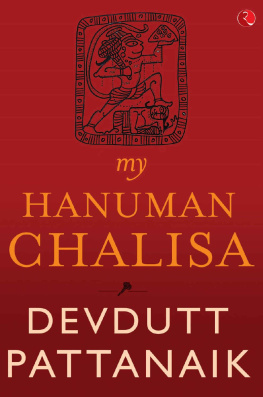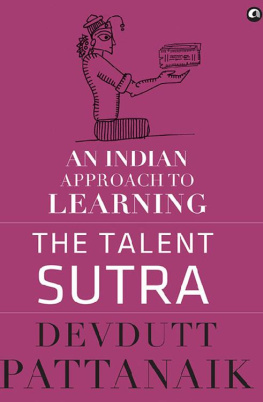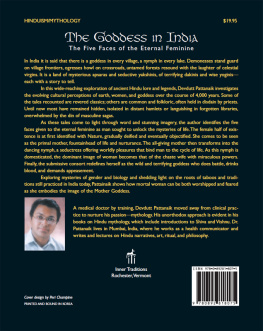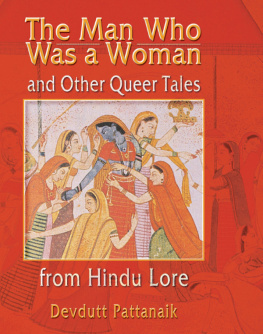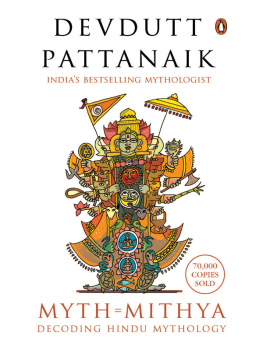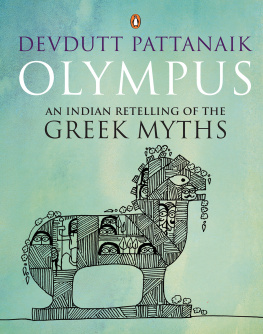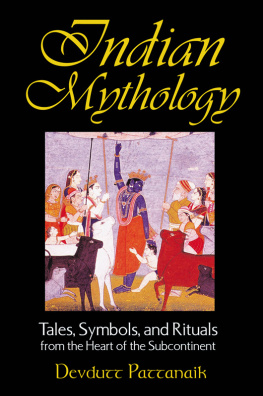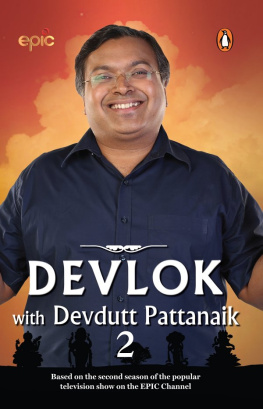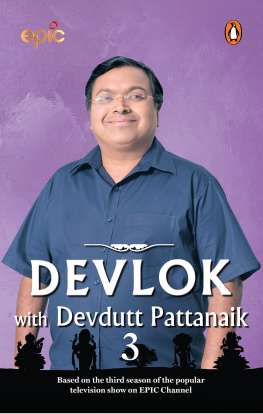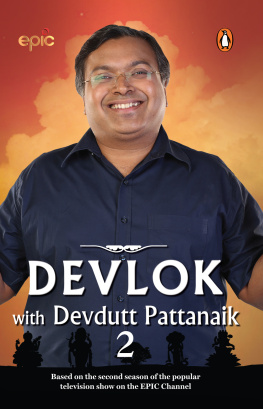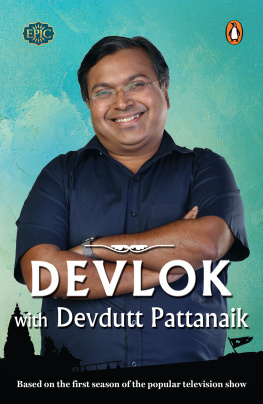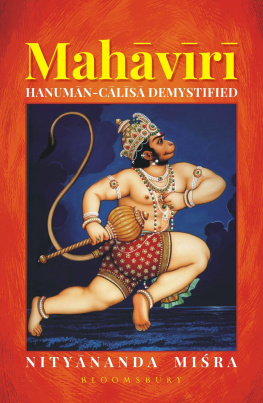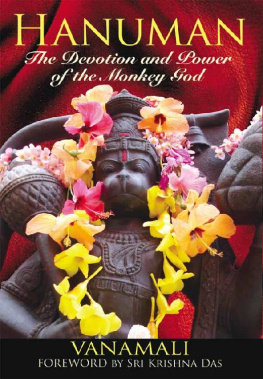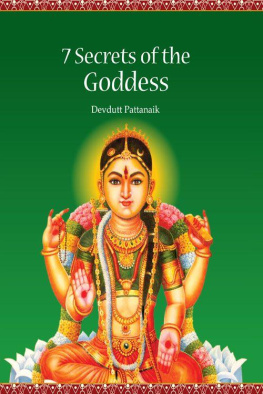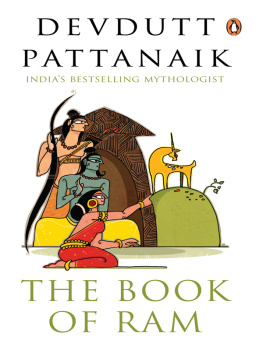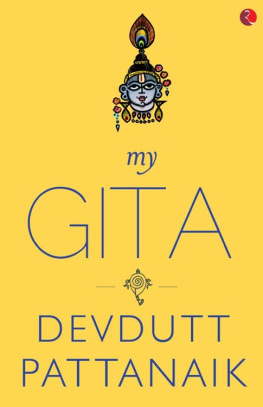my
HANUMAN
CHALISA
my
HANUMAN
CHALISA
DEVDUTT
PATTANAIK
Illustrations by the author

Published by
Rupa Publications India Pvt. Ltd 2017
7/16, Ansari Road, Daryaganj
New Delhi 110002
Copyright Devdutt Pattanaik 2017
Illustrations Copyright Devdutt Pattanaik 2017
Cover illustration: Hanuman carrying the mountain bearing the Sanjivani herb while crushing the demon Kalanemi underfoot.
The views and opinions expressed in this book are the authors own and the facts are as reported by him which have been verified to the extent possible, and the publishers are not in any way liable for the same.
All rights reserved.
No part of this publication may be reproduced, transmitted, or stored in a retrieval system, in any form or by any means, electronic, mechanical, photocopying, recording or otherwise, without the prior permission of the publisher.
ISBN: 978-81-291-3770-8
First impression 2017
10 9 8 7 6 5 4 3 2 1
The moral right of the author has been asserted.
This edition is for sale in the Indian Subcontinent only.
Design and typeset in Garamond by Special Effects, Mumbai
This book is sold subject to the condition that it shall not, by way of trade or otherwise, be lent, resold, hired out, or otherwise circulated, without the publishers prior consent, in any form of binding or cover other than that in which it is published.

To the trolls, without and within
Contents
Why My Hanuman Chalisa?
One of the things that catch your eye in the middle of a horrifyingly crowded Mumbai local train is the sight of people sitting or standing in a corner, reading from a tiny chapbook sold in roadside shops near temples. Most popular of these chapbooks is the Hanuman Chalisa. In the midst of the crushing inhumanity that is urban life, you see a glow on the readers face. It is the most powerful expression of personal Hinduism that one can encounter on Indias streets.
I have always wondered what the Hanuman Chalisa is and what is in it that makes it so popular. Its languageAwadhiis an old dialect of Hindi, one of the many languages of India. Do people reading it understand what they are reading? Or does the gentle poetic rhythm calm the nervous heart, as it prepares to face the day? Or is it simply a ritual exercise, where the point is to do, not think or feel?
So I decided to explore this popular religious work through which a Hindu god is made accessible to the masses. I realized that reading this chapbook is completely voluntary, as in all things Hindu. It is neither a commandment of a guru, nor a prescription of a priest. Its popularity is organic. Its ordinariness makes it sublime.
As I explored this work, I realized each line allows us to leap into the vast body of Hindu thought, a heritage of over 4,000 years ago, much as Hanuman leapt from his cradle to the sun, or across the sea towards Lanka, or over land towards the mountain bearing the Sanjivani herb, always returning to find Ram. From the particular, we traverse the universal, and finally return to the personal.
As you go through the forty-three verses in this book, you will notice how sensitively the poet has structured his work, how it creates a temple in the mind, and enshrines a deity in that temple, and how the verses take us from ideas of birth, through ideas of adventure, duty and glory, to the ideas of death and rebirth.
In my work, I have always avoided the academic approach, as scholars are too busy seeking the truth while I am interested in expanding my truth and the truth of my readers. If you seek 100% perfection, you often lose 99% of readers in cantankerous and often self-serving debates; but if you seek 90% perfection, you are able to reach out to over 90% of readers through thought-provoking elaborations that seek not to convince but to enrich. And that is good enough for me. Hence I present to you my Hanuman Chalisa, firmly anchored in the belief that:
Within infinite myths lies an eternal truth
Who sees it all?
Varuna has but a thousand eyes
Indra, a hundred
You and I, only two.

The Text

Shri guru charan saroj-raj nija manu mukura sudhaari.
Baranau Raghubara Vimala Jasu jo dayaka phala chari.
Buddhi-heen tanu janikay sumirow pavanakumara.
bala-buddhi vidya dehoo mohee harahu klesa vikaara.
- Jai Hanuman gyan gun sagar. Jai Kapish tihun lok ujagar.
- Ram doot atulit bala dhama. Anjani-putra Pavan-sut nama.
- Mahabir Bikram Bajrangi. Kumati nivar sumati ke sangi.
- Kanchan varan viraj subesa. Kanan kundal kunchit kesa.
- Hath vajra aur dhvaja biraje. Kaandhe moonj janehu sajai.
- Sankar-suvan Kesari nandan. Tej prataap maha jag bandan.
- Vidyavaan guni ati chatur. Ram kaj karibe ko aatur
- Prabhu charitra sunibe ko rasiya. Ram Lakhan Sita man basiya.
- Sukshma roop dhari Siyahi dikhava. Vikat roop dhari Lank jarava.
- Bhima roop dhari asur sanghare. Ramachandra ke kaj sanvare.
- Laye Sanjivan Lakhan jiyaye. Shri Raghuvir harashi ur laye.
- Raghupati kinhi bahut badai. Tum mam priye Bharat hi sam bhai.
- Sahas badan tumharo jasa gaave. Asa kahi Shripati kanth lagaave.
- Sankadhik Brahmaadi muneesa. Narad-Sarad sahita Aheesa.
- Jam Kubera Digpaal jahan te. Kavi kovid kahi sake kahan te.
- Tum upkar Sugrivahin keenha. Ram milaye rajpad deenha.
- Tumharo mantra Vibhishan maana. Lankeshwar bhaye sub jag jana.
- Yug sahastra jojan par Bhanu. Leelyo tahi madhur phal janu.
- Prabhu mudrika meli mukh mahee. Jaladhi langhi gaye achraj nahee.
- Durgam kaj jagath ke jete. Sugam anugraha tumhre tete.
- Ram dwaare tum rakhvare. Hoat na agya bin paisare.
- Sub sukh lahae tumhari sarna. Tum rakshak kahu ko darna.
- Aapan tej samharo aapai. Teenhon lok hank te kanpai.
- Bhoot pisaach nikat nahin aavai. Mahabir jab naam sunavae.
- Nase rog harae sab peera. Japat nirantar Hanumat Beera.
- Sankat se Hanuman chudavae. Man, kram, vachan dhyan jo lavai.
- Sab par Ram tapasvee raja. Tin ke kaj sakal tum saja.
- Aur manorath jo koi lavai. Sohi amit jeevan phal pavai.
- Chaaron jug partap tumhara. Hai persidh jagat ujiyara.
- Sadhu sant ke tum rakhware. Asur nikandan Ram dulhare.
- Ashta-sidhi nav nidhi ke dhata. As bar deen Janki mata.
- Ram rasayan tumhare pasa. Sada raho Raghupati ke dasa.
- Tumhare bhajan Ram ko pavai. Janam-janam ke dukh bisraavai.
- Ant-kaal Raghuvir-pur jayee. Jahan janam Hari-bhakt kahayee.
- Aur devta chit na dharehi. Hanumat se hi sarve sukh karehi.
- Sankat kate mite sab peera. Jo sumirai Hanumat Balbeera

